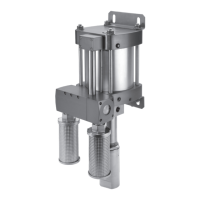6
Parker Autoclave Engineers
Instrumentation Products Division
Erie, PA USA
www.autoclave.com | Cat. 02-9309ME
Pumps are not designed to run for long periods of time without
liquid process media. Short, dry pumping cycles should not be
a cause for concern. However, pumps are built using lubricant
in the seal areas and pumping without uid will wear away
lubricant and compromise the seal.
The operating temperatures of the pump are between 0°F to
140°F (18°F to 60°F).
Section 9.0
Pump Functionality
When the pump is installed, maximum system air is connected
to 1/8" FNPT pilot air inlet and is sealed off by pilot valve as-
sembly in the top end cap and does not enter the spool housing.
Regulated air is connected to the spool housing at the 3/4" FNPT
pump inlet.
1) Regulated inlet air pressure enters spool hous-
ing and moves spool to the left directing air into
large pressure tube to the bottom end cap pushing
the air piston and liquid plunger upward.
2) The upward movement causes a suction of liquid
into the high pressure pump head while inlet check
valve is open and outlet check valve is closed. The
outlet check valve and a second hydraulic seal attached
to plunger allows liquid in the head to be compressed
and high pressure to ow during the suction stroke.
3) The air piston continues to move up until it hits the
pilot valve assembly in the top end cap.
4) The top pilot valve opens allowing max system air
pressure to shift the spool valve so that it now
directs air drive pressure through the top end cap
and pushes the air piston and liquid plunger
downward.
5) The plunger action moving down compresses the
uid on the high pressure pump head while the
inlet check valve is closed and outlet check valve is
open to allow high pressure ow.
6) While the air drive pressure is acting on top of the
piston, the bottom area of the piston is vented
through the exhaust mufer.
7) Piston continues to move down until it hits the pilot
valve assembly in the bottom end cap.
8) The bottom pilot opens which vents max system
air pressure from the large diameter side of the spool.
9) This causes spool to move to the left, while air is
vented from the top end of the air cylinder through
the exhaust mufer.
10) The entire process starts again at step one until
the maximum outlet hydraulic pressure in reached
based on the pressure ratio of the pump.
seCTion 10.0
Suggested Maintenance
A. Before each pump use, a quick inspection should be
performed to insure there are no loose bolts, nuts, set
screws or check valve glands. Tighten any lose bolts
andttingsaccordingtothetorquevalueslistedonthe
pump assembly drawing. A visual inspection should
also be made before each use and at startup to make
surethereisnoevidenceofuidleaksfromisolation
chamber drain ports, check valves connections and
mufer.Ifliquidmistsoutofthemuferformorethan5
strokes, it is time to replace your hydraulic high pres-
sure seals. Refer to the troubleshooting guide for solu-
tionstotheseuidleaks.
B. The maintenance schedule of the pump depends on
the frequency of use, cleanliness of media, type of
media, cycle rates, output pressures, cleanliness of air
or any other conditions that may be damaging to seal
integrity. Once a clear pattern develops of how long a
pump is in service before pump performance declines,
it is recommended to perform maintenance in advance
of this time frame. At minimum, perform maintenance
on the pump once a year as described below.
Maintenance would include:
•Re-lubricationorreplacementofspoolvalveo-ring
•Re-lubricationorreplacementofairdriveseals
•Re-lubricationorreplacementofpilotvalveo-rings
and gaskets
•Replacecheckvalvecomponents
•Replacehighpressurehydraulicseals
All pumps must be inspected periodically in order to
assure proper and safe operating condition.
Failure to inspect pump can result in serious and
catastrophic harm to personnel and the surrounding facility.
WARNING
The user is required to verify material compatibility with
uid based on corrosion resistance. A material list is
provided on the assembly drawing to
aid you in the evaluation.
WARNING

